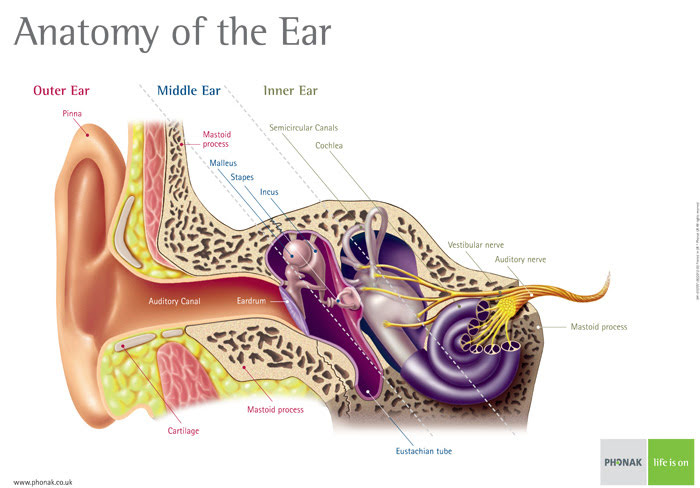What are the different types of hearing loss?
Asked by Jason Sinclair on 26 February 2019
What are the different types of hearing loss? I have heard there is three and also four?
Answered by Geoffrey Cooling
 Traditionally we considered there to be three type of hearing loss, however, in the recent past, we have recognised four distinct types of hearing loss. The four types of hearing loss are:
Traditionally we considered there to be three type of hearing loss, however, in the recent past, we have recognised four distinct types of hearing loss. The four types of hearing loss are:
- Sensorineural hearing loss (damage to the inner ear or nerve of hearing and probably the most prevalent)
- Conductive hearing loss (damage to the middle ear or outer ear and less prevalent)
- Mixed hearing loss (which is a mixture of both conductive and sensorineural hearing loss)
- Auditory processing disorders (problems in the processing centres of the brain)
Let's take a look at them in turn.
Sensorineural Hearing Loss:
A sensorineural loss results from some damage to the inner ear (cochlea) or more rarely, the nerve of hearing. In the past it has been commonly referred to as a nerve-related hearing loss or nerve deafness. The hearing loss can range from mild to profound and often affects certain frequencies of hearing more than others. More often than not, in acquired (anytime after birth) sensorineural hearing loss, the higher frequencies are worst affected. The only treatment for sensorineural hearing loss at present is hearing aids, however,there are many labs around the world working on possible genetic fixes. The hgeneral causes of a sensorineural hearing loss are:
- Age-related hearing loss (presbyacusis). This is the natural decline in hearing that many people experience as they get older. It’s partly due to the loss of hair cells in the cochlea.
- Acoustic trauma (injury caused by loud noise) can damage hair cells.
- Certain viral or bacterial infections such as mumps or meningitis can lead to loss of hair cells or other damage to the auditory nerve.
- Ménière’s disease, which causes dizziness, tinnitus, and hearing loss.
- Certain drugs, such as some powerful antibiotics, can cause permanent hearing loss. At high doses, aspirin is thought to cause temporary tinnitus – a persistent ringing in the ears. The antimalarial drug quinine can also cause tinnitus, but it’s not thought to cause permanent damage.
- Acoustic neuroma. This is a benign (non-cancerous) tumour affecting the auditory nerve. It needs to be observed and is sometimes treated with surgery.
- Other neurological (affecting the brain or nervous system) conditions such as multiple sclerosis, stroke, or a brain tumour.
Conductive Hearing Loss:
A conductive loss is a problem within the ear canal or middle ear, it is caused by diseases or obstructions in the outer or middle ear. Some conductive hearing losses are temporary, some are chronic or long term. Conductive loss can often be medically treated sometimes with surgery, temporary conductive losses (usually caused by mid-ear infections) are often treated with medication. For instance, Otosclerosis which is a middle ear condition is often sucessfully treated with surgery. Otitis Media, which is an infection of the middle ear is most often treted with antibiotics. For a conductive hearing loss of a more chronic nature, a hearing aid is generally a fantastic solution delivering real benefit. The general causes of a sensorineural loss are:
- Middle ear infections (otitis media).
- Collection of fluid in the middle ear (“glue ear” in children).
- Blockage of the outer ear, most commonly by wax.
- Otosclerosis, a condition in which the ossicles of the middle ear harden and become less mobile.
- Damage to the ossicles, for example by a serious infection or head injury.
- Perforated (pierced) eardrum, which can be caused by an untreated ear infection, head injury or a blow to the ear, or from poking something in your ear.
Mixed Hearing Loss:
A mixed hearing loss is as it sounds, it is a mix of both conductive and sensorineural hearing losses that occur in both the inner and outer or middle ear. A mixed hearing loss tends to be pretty rare and normally, the conductive element happens first and over time, the sensorineural element begins to appear. In general, there may be medical treatment for the conductive element, however, the sensorineural element can only be treated with hearing aids. Depending on the hearing loss, the repair of the conductive element may make a massive difference to how well someone can hear.
Auditory Processing Disorders:
We have known about auditory processing disorders for some time, however, in the recent past we appear to have seen an increase in prevalence. Although, in fairness that may just be that more people are worried about their hearing health and therefore presenting for testing. A typical APD case is someone who has the normal ability to hear when tested with standard pure tone audiometry. However, their ability to process speech in noise is dramatically different from the norm. For this reason, it has often been referred to as Hidden Hearing Loss by much of the wider media. We still have little understanding of this problem, we know it is a processing issue, but not why it may occur. The treatment for APD may include sound training which helps to stimulate processing and in some cases hearing aids.
We have a page devoted to hearing loss on the site called surprisingly enough All About Hearing Loss which you can read to get a little deeper information. You can also listen to our podcast on the subject below:
Subscribe to our Newsletter
Don't worry, we hate spam too - that's why we only send out content you will want to read.
Looking For Hearing Aids or A Hearing Test?
We can arrange a consultation with a trusted Independent hearing healthcare professional in your area


